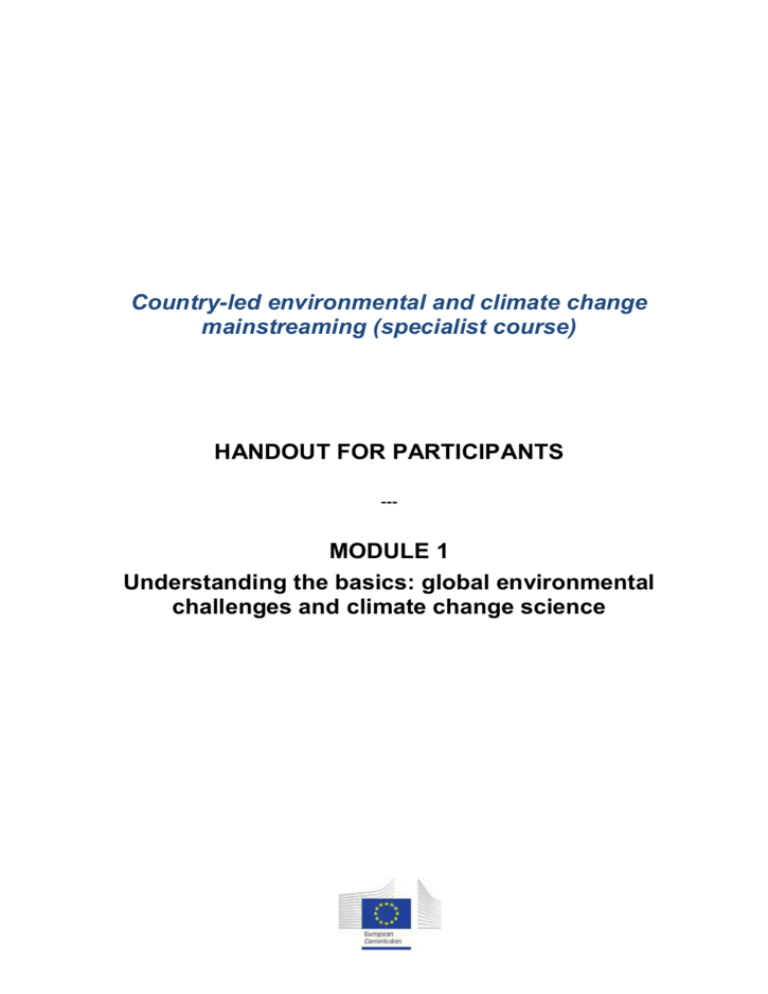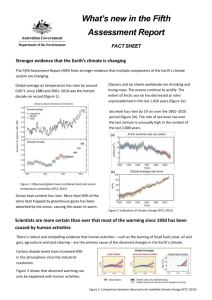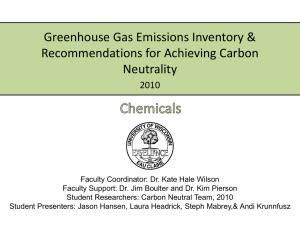global environmental challenges and climate
advertisement

Country-led environmental and climate change mainstreaming (specialist course) HANDOUT FOR PARTICIPANTS --- MODULE 1 Understanding the basics: global environmental challenges and climate change science MODULE 1 – Understanding the basics: global environmental challenges and climate change science TOPICS COVERED BY THE MODULE: - Planetary boundaries State of key global environmental variables Observed climatic trends and changes Causes of climate change: greenhouse gas emissions and the greenhouse effect Main consequences of climate change KEY CONCEPTS AND MESSAGES: Planetary boundaries 1. We are moving out of the Holocene into what is now usually referred to as the Anthropocene. During the past 10,000 years the environment has been very stable, a condition that has been fundamental to the rise of civilisation as we know it. However, human action since the Industrial Revolution is producing global environmental change, to the extent that it could push the Earth system outside the stable environmental state of the Holocene, with detrimental and potentially catastrophic consequences. (Rockström et al, 2009a). This is mainly due to a population growth (a four-fold increase in the last 100 years) and growth in economic activity (20-fold increase in GDP in the last century). 2. Certain variables can be used as indicators of the planet’s resilience. When certain boundaries exceed a threshold, systemic changes are likely to occur leading to irreversible changes. A number of key ‘planetary systems’ have been suggested as critical: (a) climate change; (b) ocean acidification; (c) stratospheric ozone depletion; (d) nitrogen and phosphorous cycle (geochemical flow cycle); (e) global freshwater use; (f) change in land use; (g) biodiversity loss; (h) atmospheric aerosol loading; and (i) chemical pollution. Module 1: Understanding the basics: environmental challenges and climate change science Figure 3.1 – Planetary systems and their thresholds State of key global environmental variables 3. Out of the key planetary systems described above, the last two (i.e. atmospheric aerosol loading and chemical pollution) have not yet been quantified; as for the others, safe thresholds have already been exceeded for climate change, biodiversity loss and nitrogen cycle, whereas the phosphorous cycle and ocean acidification are approaching their respective thresholds. 4. With respect to climate change, atmospheric CO2 concentrations have reached 387 ppm as compared to a safe level of 350 ppm; likewise the safe level for radiative forcing of 1 W/m 2 has been exceeded and now stands at 1.5 W/m2. More information on climate change is provided below. 5. In terms of biodiversity loss, species are becoming extinct at a rate between 100 and 1000 times the natural rate, something that had not occurred since the last global mass extinction. The main cause is land use change (into agricultural land), as well as the introduction of new species. 6. Human action has significantly altered the nitrogen and phosphorous cycles, mainly due to the addition of N and P to satisfy the requirements of modern agriculture. Human processes are responsible for the conversion of 120 million tonnes of nitrogen per year, more than that due to all natural processes combined. As well, about 20 million tonnes of phosphorous are mined each year, i.e. 8 times the natural background rate of influx. Nitrogen and phosphorous, which is mainly used in agriculture, end up polluting waterways and coastal waters, with their consequent effects on biodiversity and availability of clean water (and thus, also on human health). 7. Most freshwater flows are now controlled by humans, and pressure on this resource is growing rapidly, mainly in the context of increased demand for food production (i.e. irrigation). There is a close link between green water flows (soil moisture) and blue water flows (fresh water), which could lead to e.g. savannisation of the Amazon basin, just as the Sahel shifted from being a wet to a dry area some 5,000-6,000 years ago. Land use change, especially deforestation, is leading to reductions in freshwater availability, whereas changes in other planetary systems (nitrogen and phosphorous cycles and use of chemicals) are polluting freshwater, rendering it unsuitable to satisfy some ecosystem services. Module 1: Understanding the basics: environmental challenges and climate change science 8. Land use change is mainly driven by agricultural expansion and intensification, which has been occurring at an average rate of 0.8% per year over the past 40-50 years. Land use change directly affects other planetary systems, especially biodiversity, freshwater availability and climate change. 9. Ocean acidification affects the marine carbon sink and also poses a challenge to marine biodiversity; some organisms are highly sensitive to changes in CO2 chemistry, especially those that grow protective shells and skeletal structures as well as corals. Impacts on these organisms affect the food chain and fish spawning grounds. 10. Chemicals tend to end up as pollutants of waterways, soil and the atmosphere. There are over 248,000 chemicals commercially available, although only a few thousand have been thoroughly tested, and there is little knowledge about synergistic and cumulative effects. Some chemicals are particularly dangerous as they do not degrade (Persistent Organic Pollutants – POPs and heavy metals), and can thus get transported to remote regions of the planet, bioaccumulating in organisms and getting passed up the food chain. Pesticides are also a big concern due to the large amounts being used, often (and especially in developing countries) inadequately and in absence of safety equipment and measures. Observed climatic trends and changes 11. There is no doubt that the earth’s climate is getting warmer. Observed trends are clear and all point in the same direction. Manifestations of this change notably include increased average air temperatures, increased average ocean temperatures, widespread melting of snow and ice, and rising sea levels. As a result, changes are observed in physical systems (e.g. melting of the permafrost, alterations in hydrological patterns and flows) and in biological systems (e.g. shifts in the range of some terrestrial species, shifts in the range and abundance of plankton and fish). Many documented changes in ecosystems that are attributable at least in part to other causes are also likely to be exacerbated by climate change (e.g. losses of coastal wetlands, mangroves and coral reefs) (IPCC 2007a2007b & IPCC 2007c, World Bank 2010a). Causes of climate change: greenhouse gas emissions and the greenhouse effect 12. Natural variability is an inherent feature of the climate, but there is no longer any reasonable doubt that the changes we are observing today are to a large extent driven by anthropogenic emissions of long-lived greenhouse gases (GHGs). Indeed, human activities cause unprecedented emissions of such GHGs, and they have accumulated in the atmosphere at levels not observed over the past 650,000 years (IPCC 2007a & 2007b, World Bank 2010a). 13. Climate change is caused by the greenhouse effect, a phenomenon by which GHGs in the atmosphere trap part of the infrared radiation that the earth (heated by the sun’s energy) radiates back to space (see Figure 3.1). The greenhouse effect is a natural phenomenon, which is most useful since it allows maintaining the average global temperature at 15°C (rather than –18°C in the absence of GHGs). However, fast increasing atmospheric concentrations of GHGs as a result of ever-increasing anthropogenic emissions are now causing a very fast (by geological time) and very significant increase in temperature at the surface of the earth (IPCC 2007a, http://wwf.panda.org). 14. With the exception of chlorofluorocarbons (CFCs) and other halogenated compounds, which are the product of industrial activity, other major GHGs (i.e. carbon dioxide, methane, nitrous oxide and ozone1) are naturally present in the atmosphere. However, human-driven emissions of these Water vapour is also a GHG. Its presence in the atmosphere results from natural processes (the hydrological cycle). 1 Module 1: Understanding the basics: environmental challenges and climate change science gases, as a result of fossil fuel burning, agriculture and land use change, have added significantly to their natural levels in the atmosphere (IPCC 2007a & 2007b). Figure 3.1 – The greenhouse effect Source: WWF/IPCC (http://wwf.panda.org/about_our_earth/aboutcc/how_cc_works/) 15. There are various ways of accounting for the contribution of various GHGs to climate change. One of them is the global warming potential (GWP, expressed in tonnes of CO2 equivalent or t CO2e). This is a measure of how much a given mass of a GHG is estimated to contribute to global warming, compared with the same mass of CO2 (by convention, GWP of CO2 = 1). It is used (notably in the context of the Kyoto Protocol) to estimate the potential future impacts of emissions of different gases on the climate, in a relative manner. The GWP depends on the time span over which it is calculated, as shown in Table 3.1; for instance, over a 100-year period (the reference period used under the Kyoto Protocol), methane has a GWP of 25, nitrous oxide of 298, CFC-11 (an ozone-depleting substance phased out under the Montreal Protocol) of 4,750, and HFC-23 (a substance temporarily used as a substitute for chlorofluorocarbons) of 22,800; fortunately, these gases with a very high GWP are much less abundant than carbon dioxide (IPCC 2007b). Table 3.1 – Global warming potential of some greenhouse gases GHG Over 20 years Over 100 years Lifetime (years) Methane 72 25 12 Nitrous oxide 289 298 114 CFC-11 (N.B. ozone depleting substance) 6,730 4,750 45 HFC-23 12,000 14,800 270 SF-6 16,300 22,800 3,200 Source: Adapted from IPCC (2007b) Climate Change 2007: The Physical Science Basis. Table 2.14, p. 212. Module 1: Understanding the basics: environmental challenges and climate change science 16. Historically, the use of energy obtained from fossil fuels is the main contributor to anthropogenic emissions of GHGs. Over the past few decades, agricultural practices and land use changes have emerged as other significant sources of emissions. Today, the various uses of energy still account for about two-thirds of total GHG emissions. Land use changes (primarily deforestation) and agriculture contribute 13-15% each. Industrial processes (other than energy use) contribute another 4%, and the waste sector about 3%. The World Resources Institute’s ‘World Greenhouse Gas Emissions Flow Chart (2005)’, shown in Figure 3.2, illustrates the contribution of various human activities to GHG emissions at the global level. Figure 3.2 – World Greenhouse Gas Emissions Flow Chart (2005) Copyright: World Resources Institute, Washington, DC Source: Herzog (2005) World Greenhouse Gas Emissions in 2005, p. 2 Main consequences of climate change 17. Using a variety of scenarios for future GHG emissions, the IPCC has prepared projections for the end of the 21st century. Relative to the period 1980-1999 and depending on the chosen scenario, expected increases in global average temperature by the end of this century range between 1.1 and 6.4°C, while the range in sea level rise would be between 0.18 and 0.59 m. (These projections are now considered quite conservative by some experts, in particular with regard to sea level rise.) As already mentioned, changes in the climate system result in changes in physical and biological systems, which in turn lead to socio-economic impacts (EC 2009a). Figure 3.3 provides a summary of the main biophysical and socio-economic impacts. Module 1: Understanding the basics: environmental challenges and climate change science Figure 3.3 – Biophysical and socio-economic impacts of climate change Biophysical impacts Socioeconomic impacts Changes in t° Changes in rainfall patterns Shifts in seasons More frequent or severe storms, floods, droughts Raised sea level Erosion, desertification Changes in water quality/availability Changes in ecosystems Biodiversity loss Disease & pest outbreaks, ... Damage to or destruction of infrastructure Reduced food security, malnutrition Economic disruption, loss of livelihoods, social disruption Increased mortality and morbidity Reduced availability of hydropower Conflicts, population displacement, human migrations, ... Source: EC (2009a)/GCCA Support Facility Summary 18. Figure 3.4 provides a schematic framework of anthropogenic drivers of climate change, how earth and human systems interact, and the role of adaptation and mitigation responses. Module 1: Understanding the basics: environmental challenges and climate change science Figure 3.4 – Schematic framework of anthropogenic climate change drivers, impacts and responses Source: IPCC (2007a) Climate Change 2007: Synthesis Report. Figure I.1, p. 26. REFERENCES: EC (2009a) EC Cooperation: Responding to Climate Change – ‘Sector scripts’ series. See in particular ‘Sector Scripts: Introduction and Key Concepts’. [On CD-ROM] Hassan, R; Scholes, R and Ash, N (Eds.) (2005) Ecosystems and Human Well Being, Volume 1: current state and trends (Millennium Ecosystem Assessment). Island Press: Washington, Covelo, London. Herzog T. (2005) World Greenhouse Gas Emissions in 2005. Working paper, World Resources Institute, Washington, DC. Available from: http://www.wri.org/publication/world-greenhouse-gas-emissions-in2005 IPCC (2007a) Climate Change 2007: Synthesis Report. Contribution of Working Groups I, II and II to the Fourth Assessment Report. [Core Writing Team, Pachaury R.K. & Reisinger A. (eds.)] Intergovernmental Panel on Climate Change, Geneva. Available from: www.ipcc.ch. IPCC (2007b) Climate Change 2007: The Physical Science Basis. Contribution of Working Group I to the Fourth Assessment Report of the Intergovernmental Panel on Climate Change [Solomon S., Qin D., Manning M., Chen Z., Marquis M., Averyt K.B. , Tignor M. & Miller H.L. (eds.)]. Cambridge University Press, Cambridge, UK & New York, NY, USA. Available from: www.ipcc.ch. IPCC (2007c) Climate Change 2007: Impacts, Adaptation and Vulnerability. Contribution of Working Group II to the Fourth Assessment Report of the Intergovernmental Panel on Climate Change [Parry Module 1: Understanding the basics: environmental challenges and climate change science M.L., Canziani O.F., Palutikof J.P., van der Linden P.J. & Hanson C.E. (eds.)]. Cambridge University Press, Cambridge, UK & New York, NY, USA. Available from: www.ipcc.ch. Roskström et al (2009a) A safe operating space for humanity. Nature, Vol. 461, 24 September, 2009. Roskström et al (2009b) Planetary boundaries: exploring the safe operating space for humanity. Ecology and Society, 14(2): 32. UNEP (2012) Global Environment Outlook GEO5, Environment for the future we want. World Bank (2010a) Development and Climate Change. World Development Report 2010. World Bank, Washington, DC. Available from: http://go.worldbank.org/ZXULQ9SCCO USEFUL WEBSITES: CO2 Now (volunteer-driven information website about atmospheric concentration of greenhouse gases and climate change science): http://co2now.org/ Millennium Ecosystem Assessment: www.unep.org/meaweb/ UNEP Environmental Data Explorer: http://geodata.grid.unep.ch/ WWF – Climate change explained: http://wwf.panda.org/about_our_earth/aboutcc/how_cc_works/ Module 1: Understanding the basics: environmental challenges and climate change science







